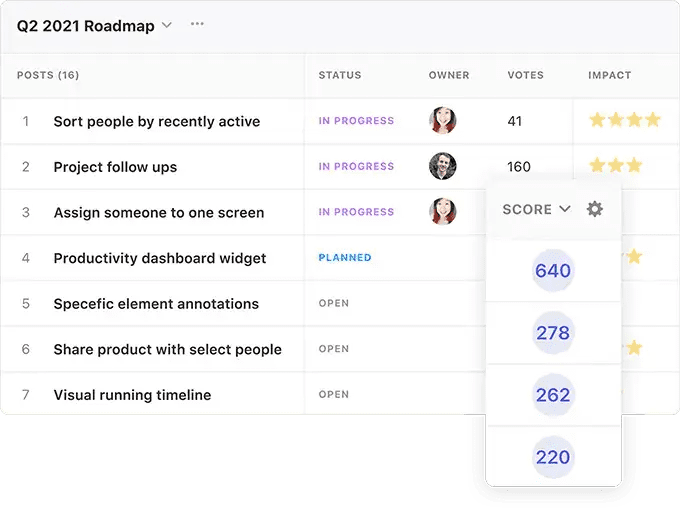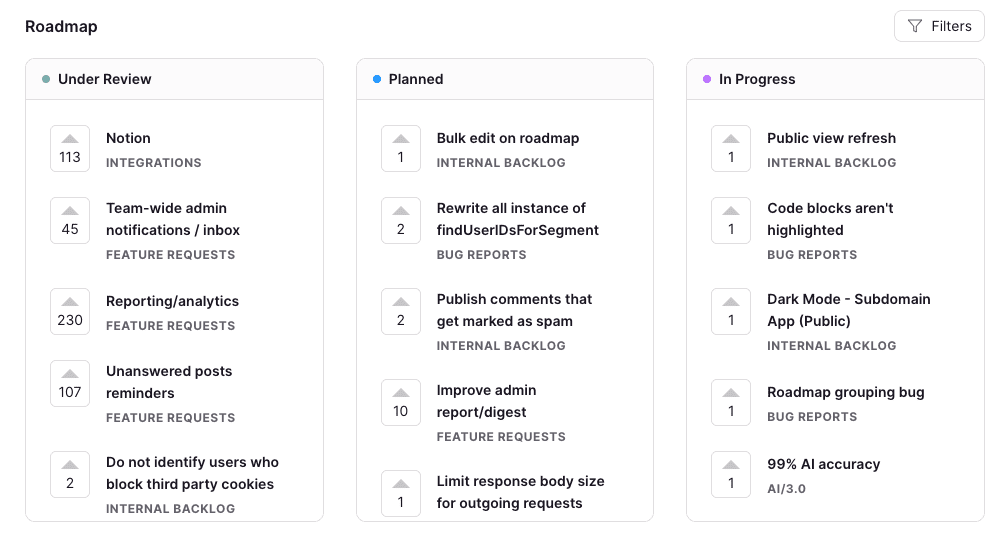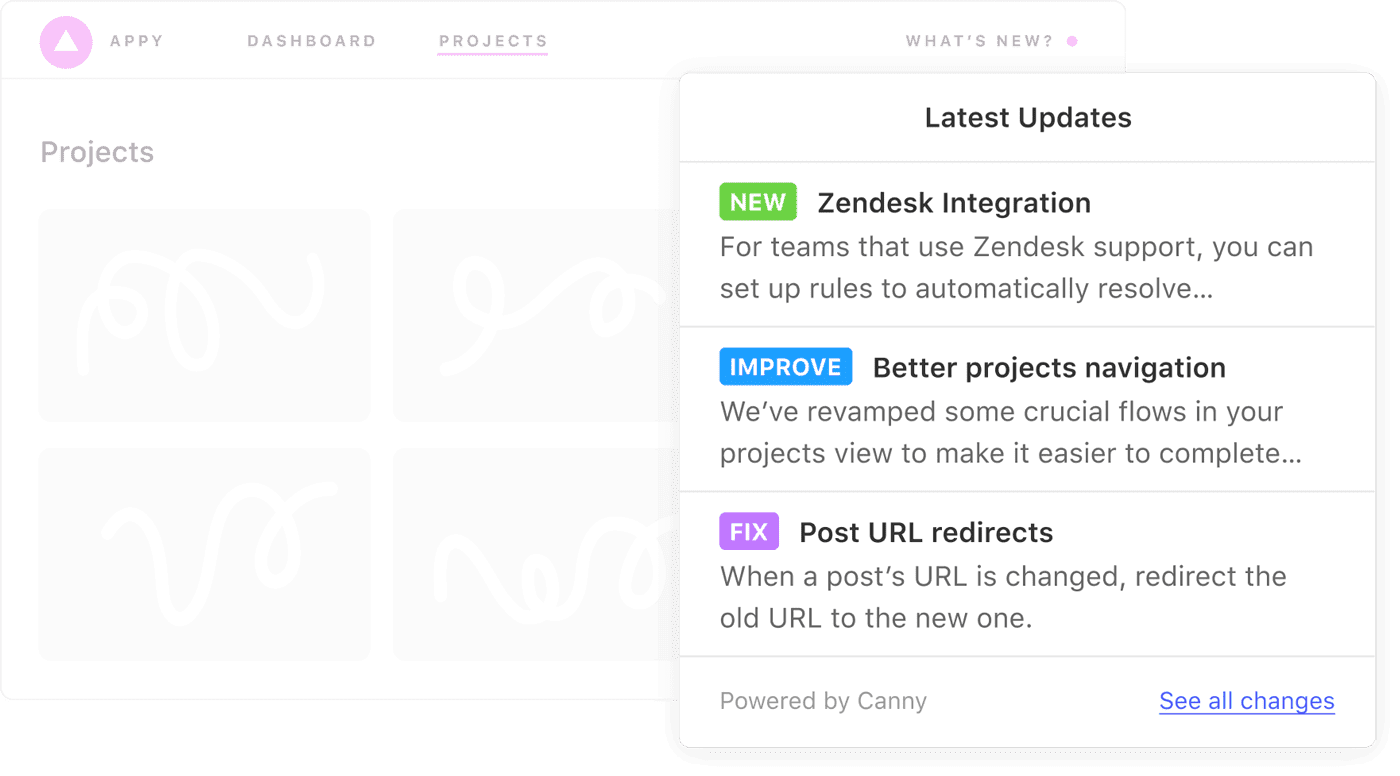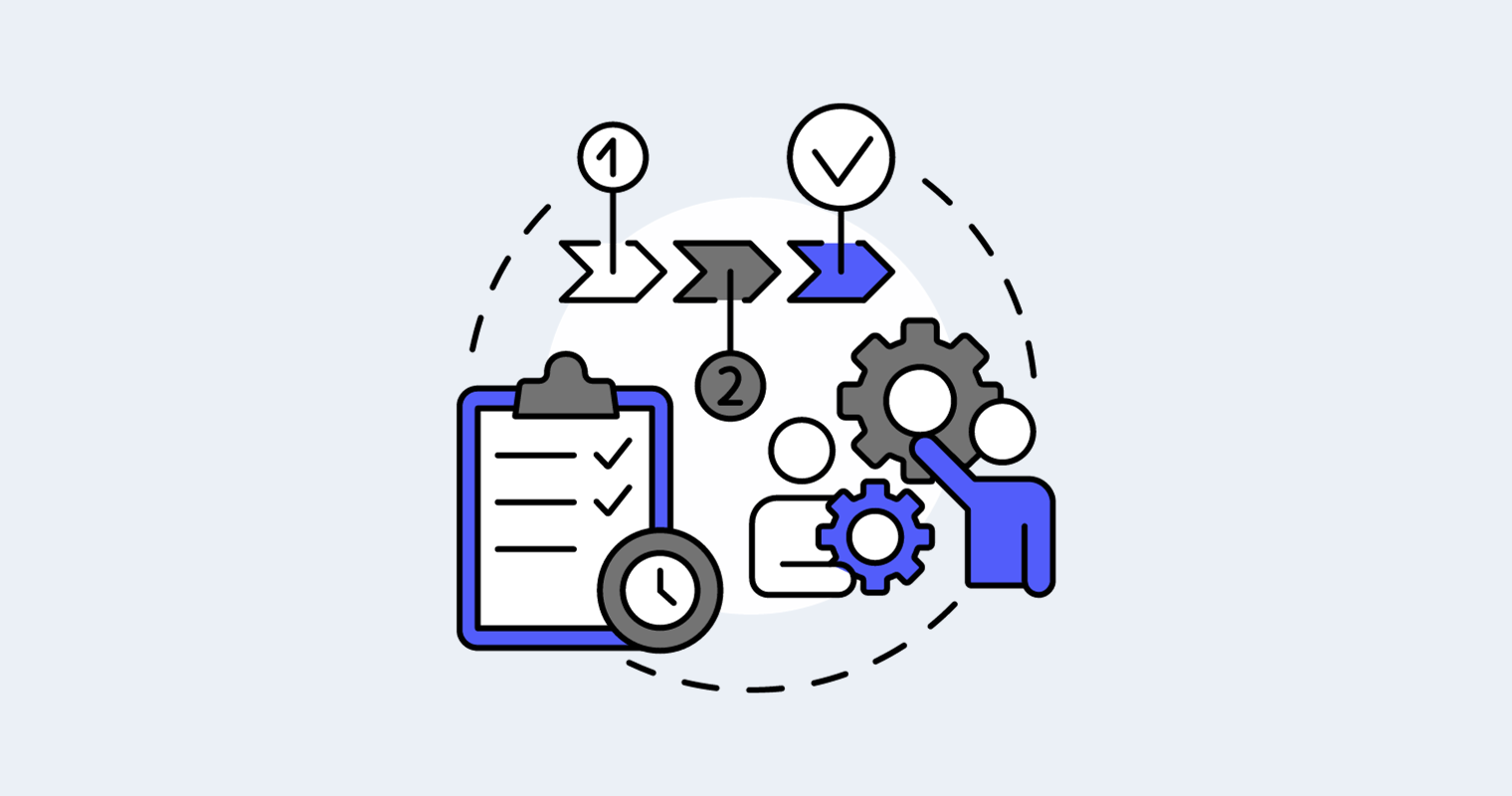Ever feel like your team is lost in a sea of technology solutions? That’s where a technology roadmap comes to the rescue. But what exactly is it?
This guide can help you manage tech decisions and keep your business on course. We’ll explain exactly what tech roadmaps are and how they’re used. You’ll see how to both plan and execute these roadmaps. Plus, get insights on integrating product development for smoother sailing ahead.
Aligning technology initiatives with business goals helps your company succeed. And, tech roadmaps are a great way to do that.
Curious yet? Hang tight as we embark on this journey together!
What is a technology roadmap?
A technology roadmap is a strategic document that communicates the plan for technology initiatives. They’re sometimes known as IT or technical roadmaps.
Technology initiatives could include:
- Onboarding new software
- Setting up hosting
- Creating databases
- Building physical infrastructure
- Integrating different systems together
- And many more
Tech roadmaps help organizations understand and visualize their technological needs over time. It matches company goals with specific technology solutions. Ultimately, it ensures you have the technology needed to drive innovation and growth.
Purpose and benefits
There are many benefits of building a tech roadmap:
- It aligns tech investments with business priorities
- It helps anticipate future tech needs.
- It improves communication about tech plans to your whole organization.
- It helps promote efficient resource allocations
What does that look like?
As the name suggests, it looks like a list of new tech you want to set up.
Often this will be a visual roadmap that shows what tech is coming and when. Many tech teams use tools like GitHub or Canny to visualize roadmaps. Other teams still manage their roadmaps in spreadsheets, though. Airtable or Google sheets are popular examples.

In either case, it’s important to have a good understanding of each planned technology. That includes its importance, other projects it impacts, its stakeholders, and more. We’ll cover that in more detail soon.
The beauty of a technology roadmap lies in its flexibility. Every organization can tailor one to suit its specific requirements. Here are a few examples of tech roadmaps you might see:
Key elements and components
Let’s take a quick look at the key elements that make up a technology roadmap.
Vision and strategy
The vision is the overarching goal your team wants to achieve. Your tech roadmamp needs to deliver the technology necessary to do that.
For example, your vision could be to build the web’s best stock photography site.
Strategic objectives support your vision. They are usually specific technology projects required to achieve the vision.
What would a strategic objective supporting the stock photography site example be? Well, your team might need to set up hosting on Amazon Web Services. They would also need their development environments set up.
Timeframes
You’ll want to specify what timeframes your roadmap covers. These are some common ones:
- Short-term: immediate technology projects planned for the next few months to a year.
- Medium-term: projects and initiatives planned for the next one to three years.
- Long-term: tech initiatives that are planned for three years and beyond.
Technology initiatives
These are the projects, solutions, or technologies that the organization plans to implement.
This can include software upgrades, infrastructure changes, research and development projects, etc.
Milestones
Milestones are key events that mark significant progress towards implementing a technology initiative. This could include completion of project phases, successful testing, or deployment.
Dependencies
These are relationships between different technology initiatives. They indicate which projects rely on the completion of others.
Resources
There are human, financial, and technological resources required for each initiative.
Examples include project teams’ time, budgets, hardware, software, and other assets.
Risks and challenges
There are potential issues that might hinder the successful implementation of technology initiatives. Your tech roadmap should identify and explain them. Then, develop strategies for mitigating those risks.
Stakeholders
These are the key individuals or groups who have an interest in the technology roadmap.
This can include internal teams, leadership, customers, partners, and vendors. You should specify which groups have access to the tech roadmap and how you’ll communicate it.
Review and update mechanism
You need a process to regularly review and update the technology roadmap. You’ll update based on changing business needs, technological advancements, and feedback from stakeholders.
Note: these elements provide a general framework. The specific content and structure of a technology roadmap can vary based on the organization’s needs, industry, and the complexity of its technology landscape.
These elements work together to guide where your technology should go over time.
Now, let’s put those elements to work and actually plan out your roadmap.
Planning a technology roadmap
Building a robust tech roadmap is like plotting your journey on a GPS. It needs careful planning, foresight, and adjustment to ensure you reach your destination.
Let’s look at the steps you need to take.
Identify key stakeholders
Your first step should be to identify who will use the tech or product. These are your key stakeholders. They could be anyone from customers, employees, investors, or even regulatory bodies.
Define goals and objectives
The next task at hand is setting clear goals and objectives that align with business goals. This acts as the guiding light throughout the development process.
For example, you might have a goal of setting up all tech infrastructure for a new website your team is launching. Your roadmap would focus on achieving that goal.
Evaluate technology alternatives
A critical part of this plan involves evaluating different technologies. You’ll want to identify your requirements for each project. Then, you can evaluate vendors based on your requirements and budget.
Determine necessary resources
Knowing which technologies you want to implement, you need to look at what each requires. Most will have human, financial, and technological requirements. It’s important to know what can be reasonably accomplished with your team’s bandwidth, budget, etc.
Identify dependencies
It’s very likely that some technologies rely on others being implemented first. Identify those dependencies. Make sure you account for them when planning your roadmap.
Create realistic timelines
Rome wasn’t built in a day. And neither can any decent piece of technology. Set realistic timelines for every phase of development. Consider potential roadblocks along the way.
It’s tempting to set aspirational goals. But make sure that you’re not leading yourself and your team to a burnout.
Prioritizing projects
Chances are you’ll have no shortage of technology to implement. That’s why prioritization is critical. You’ll want to develop a prioritization formula based on your team’s priorities. This lets you objectively evaluate each technology. You’ll see which are highest-priority.
Typically you’d schedule highest-priority projects first. But, you may need to adjust your roadmap based on dependencies.

Add items to your roadmap
Finally, you’ll add projects to your roadmap. Start with your high-priority projects first. Make sure it has the key elements we mentioned above.

There are many ways to present your roadmap. If you’re looking for inspiration, check out our roadmap templates.
Executing the technology roadmap
We just explored planning your roadmap. Let’s take a look at how you can execute on it.
Setting up your roadmap
You need to store your roadmap in a central location. All your stakeholders should have access to it, and be able to share their input.
Roadmaps built in spreadsheets used to be commonplace. They kind of work, but aren’tt really built for it.
Many project management tools have some basic roadmap functionality. They can work well, but often lack roadmap specific functionality you’d expect.
Tools like Canny’s roadmap builder are purpose-built for roadmapping. You can:
- Add tech projects to your roadmap
- Discuss them with stakeholders
- Prioritize projects based on your unqiue criteria
- Keep everyone updated
You can get a free account to check it out!
Assigning tasks and responsibilities
It’s crucial to clearly assign tasks when executing a technology roadmap. This makes sure everyone knows their role, helping avoid confusion and delays. That means your roadmap should integrate with your project management system.
Tools like Jira, ClickUp and Asana are great for this. Canny integrates with all these tools. So, your roadmap and project management system work together.
While project management is a huge topic, here’s one tip. When assigning tasks tied to roadmap items, be aware of how much time each task takes. You’ll want to ensure your team’s time estimates line up with your roadmap’s timelines.
Once the work is assigned you need to stay on top of it. Make sure you’re hitting your deliverables so your technology roadmap stays on track.
Engaging and communicating with stakeholders
Keeping stakeholders engaged is key for smooth execution of a tech roadmap. Regular updates on progress can make sure they stay involved.
In Canny, anyone following a project gets email updates whenever there’s progress. You can also publish release notes when you ship projects. These also notify interested stakeholders.

Monitoring and tracking progress
To ensure your plan stays on track, make sure you’re regularly monitoring progress. Are initiatives being completed according to the timeline? Have there been any delays that require you to reschedule things? Are any initiatives blocked and need outside support?
You’ll want to make sure you’re on top of questions like these. Your project management system should update you as your team progresses. So, make sure you’re up to date and adjusting as needed.
Connecting with your product roadmap
Your technology roadmap isn’t a stand-alone tool. It should sync perfectly with your product roadmap. Your technology roadmap provides the foundation your product roadmap needs to succeed.
Links between technology and product development
Tech initiatives must align with product goals. Let’s say you’re planning to enhance user experience on your app. Your tech team may need to prioritize projects around backend optimizations.
This means your technology and product roadmaps should align. Many items on the tech roadmap could be dependencies on the product roadmap.
Collaboration between the product manager and technology leader
The product manager (PM) and technology leader have distinct roles. But, their collaboration ensures alignment of tech plans with business objectives. Regular meetings or check-ins can help both stay informed about progress, obstacles, and changes in direction.
Establishing strategic direction for product and technology
This shared vision sets the path forward. The PM has deep understanding of customer needs. The tech lead’s expertise provides the infrastructure needed to solve those. They create a balanced approach towards achieving business goals while ensuring technical feasibility.
Why a technology roadmap is a great idea
Technology roadmaps can give you the upper hand in strategic planning. These tools are not just about plotting tech initiatives. They also align tech projects with business objectives and long-term goals.
Embracing technology roadmapping allows organizations to be nimble. They can anticipate changes, make informed decisions, and adapt swiftly to shifting trends.
Using technology roadmaps could be the deciding factor in staying ahead with innovation. Make sure yours is up to date so you can support your team’s growth.








